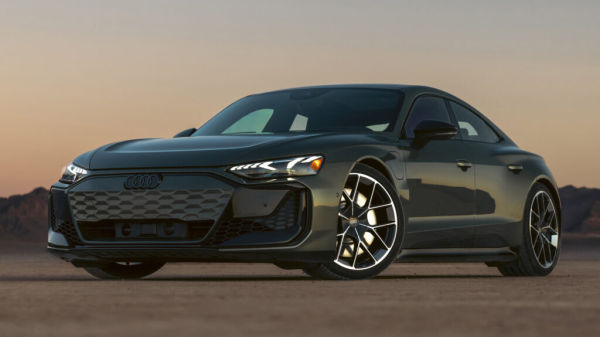Sedans are generally quite practical vehicles. They have four doors, seat four or five people, and offer decent luggage space. But practicality isn’t exactly exciting. Car makers know this, and the past decade or so has seen a proliferation of high-powered sedans boasting power numbers that would make a ’90s supercar green with envy. The rise of EVs has pushed this race to extremes, too, making 1,000-hp sedans seem almost mundane compared to just a few years ago.
Sure, not all of these burly, big-power sedans will offer the same finely-honed driving experience of a two-seater sports car or hot hatch, but they offer plenty of thrills of their own, especially when you put your foot on the throttle. Whether you’re lucky enough to be shopping for a powerful sedan or are just curious as to how crazy four-door power numbers have gotten over the past few years, we’ve assembled a list of 13 sedans — gas, PHEV, and EV — that can transport a small family and rip your face off at the same time.
A quick note before we start: Some of these models, such as the Lucid Air and Porsche Taycan, have several variants that could make the list. However, we’re limiting it to one version per nameplate for the sake of variety.
Audi RS7 Performance – 621 hp
Audi is no stranger to performance-oriented four-doors, with models like the S3, S4, and S5 (plus the sportier RS variants) often considered some of the best sports saloons money can buy. But while those are all great cars, none of them can quite play with the big boys in terms of raw power. That’s where the RS7 Performance comes in.
The RS7 Performance is one of the most powerful models in Audi’s current range, its twin-turbocharged 4.0-liter V8 making a healthy 621 hp and 627 lb-ft of torque. While that’s not the most power you’ll ever get in a sedan, it’s good enough to take the liftback to 60 mph in 3.3 seconds, all while offering plenty of thrills in the corners.
The best part is that it does all of this in quite a bit of luxury, too, as we found out during our test of the 2024 Audi RS7 Performance. Of course, this combination of power, handling, and class — not to mention amazing looks — doesn’t come cheap, but you’re not buying a 600-hp sedan if you don’t have money to burn.
BMW M8 Competition Gran Coupé – 625 hp
When is a coupé not a coupé? When it’s the BMW M8 Competition Gran Coupé, of course. Naming issues aside, the BMW M8 Competition Gran Coupé is another entry in BMW’s storied history of powerful sedans — a history admittedly dominated by the M5. But while the M8 Competition Gran Coupé may not quite have the same heritage as its more celebrated sibling, that doesn’t mean it’s not a worthy vehicle in its own right.
The M8 Competition Gran Coupé debuted alongside the M8 Gran Coupé, both packing 4.4-liter, twin-turbo V8 engines under the hood. The Gran Coupé made 600 hp, while the Competition Gran Coupé upped the ante with 625 hp. Torque was 553 lb-ft for both, and they delivered power to all four wheels via BMW’s xDrive system.
As of 2025, the M8 Competition Gran Coupé has had to deal with the ignominy of a slight power drop to 617 hp, although it retains the 553 lb-ft of torque, allowing it to hit 60 mph in a manufacturer-claimed 3.0 seconds. And even with that slight reduction in raw power output, it’s still one of the most powerful BMW models ever made.
Cadillac CT5-V Blackwing – 668 hp
The Cadillac CT5-V Blackwing is, in many ways, an anachronism. Not only is it one of the few sedans still available from an American automaker, it’s the only one with a classic V8 powerplant under the hood — at least, as of Q3 2025. On top of that, the CT5-V Blackwing is still rear-wheel drive in a world where many high-powered sedans opt for four-wheel drive instead. To top it all off, the Blackwing also has a traditional six-speed manual transmission.
So, there’s a lot to love about the CT5-V Blackwing on paper, and our test drive of a 2025 model shows that the goodness extended to the real world. The 668-hp, 659 lb-ft V8 engine is exceptional, the manual is great, and the Blackwing retains all of the luxury you’d expect from a car bearing the Cadillac name. It’s perhaps not quite as refined as its European rivals, but this American-made holdout has it where it counts. Not for nothing has it made Car and Driver’s 10Best list four times.
Don’t mistake the CT5-V for a straight-line bruiser, either. GM introduced a new Precision Package for 2025 that makes radical changes to the suspension, drivetrain, and brakes, all of which combine to greatly improve handling, especially on the track.
BMW M5 (G90) – 717 hp
If there’s a car that arguably redefined the modern sports sedan, it’s the BMW M5. First launched in 1985, the first M5 was predictably old-school by modern standards, with boxy styling, a 286-hp engine, and rear-wheel drive. While some will insist that the original M5 was essentially perfect and as good as it gets, that didn’t stop BMW from iterating heavily in the decades since.
The M5 F10 from 2011 introduced the now-familiar 4.4-liter twin-turbo V8 to the M5’s engine bay, while 2017’s M5 F90 introduced all-wheel drive. These changes to the M5’s DNA have culminated in the M5 G90, which debuted in 2024. This latest iteration of BMW’s sports sedan features the first-ever PHEV powertrain to feature in an M5, combining a 585-hp, 553-lb-ft implementation of the 4.4-liter twin-turbo V8 with an electric motor capable of 197 hp and 206 lb-ft of torque on its own.
Combined, the electrified M5 makes 717 hp and 737 lb-ft of torque. And while many have expressed doubts about the M5’s newfound bulk, we found the M5’s electrified power quite intoxicating — yet surprisingly usable — when we tested a 2025 M5 earlier in the year. Sure, it’s not the svelte sports saloon of old, but it’s every bit as good.
Porsche Panamera S Turbo E-Hybrid – 771 hp
Porsche did not establish itself in popular consciousness with four-door vehicles, and any list of the best Porsches of all time will likely be dominated by two-door cars. It could be one of the many generations of the 911, a front-engined sports car like the 924, or retro racers like the Porsche 550. Either way, it’s likely a two-door car. Despite that, the modern Porsche is no stranger to slightly more practical — yet no less performance-oriented — vehicles, such as the Panamera S Turbo-E Hybrid.
Now in its third generation, the Panamera survived its somewhat controversial looks to become a fixture of Porsche’s lineup, serving as the platform for Porsche’s first PHEV powertrain in the process. The Panamera S Turbo E-Hybrid is the current zenith of Porsche’s Panamera efforts, with a total power output of 771 hp and 737 lb-ft from its combination of a twin-turbo, 4.0-liter V8 — capable of 591 hp on its own — and an electric motor.
The result? A 0-60 mph time of 2.8 seconds (with the $1,150 Sport Chrono package) and a top speed of 202 mph in a car that weighs 5,311 pounds. And, with four doors, you can bring along a bunch of your friends to experience that electrified power first-hand.
Bentley Flying Spur Speed – 771 hp
Bentley is as prestigious as they come. Founded in 1919, Bentley established its reputation by winning the 24 Hours of Le Mans multiple times in the 1920s and releasing ultra-luxe cars such as the 1930s Bentley 8 Litre and the R-Type Continental from the 1950s. The latter combined coachbuilt opulence with a top speed of 115 mph, and it’s that combination of class and performance that the Flying Spur Speed continues to offer in 2025.
The Flying Spur Speed may carry the historic Bentley badge, but it’s anything but old-school. Underneath the swathes of curved metal that make up its 17.4-foot-long body beats an oh-so-2025 PHEV powertrain that the company calls the Ultra Performance Hybrid. It is, on paper, an identical setup to VW Group hybrids like the Porsche Panamera S Turbo E-Hybrid, which makes some sense given that the VW Group also owns Bentley.
So, what you get is a twin-turbocharged, 4.0-liter V8 that makes 591 hp, paired with a 188-hp electric motor, making for 771 hp and 738 lb-ft of torque. Those are identical numbers to the Porsche, although the Bentley’s 5,833-pound curb weight does bring its 0-60 mph time down to 3.3 seconds.
Mercedes-AMG S 63 E Performance – 791 hp
PHEV powertrains dominate the 700-hp range, which makes a lot of sense: twin-turbo V8s can easily make 500 to 600 hp, and electric motors can push the combined output above 700 horses. BMW, Porsche, and Bentley have all gone down this route with their high-powered sedans, and Mercedes-Benz is no exception.
The crowning jewel of Mercedes’ hybridized super sedans is the Mercedes-AMG S 63 E Performance, which Mercedes-AMG reintroduced to its lineup as a performance PHEV in 2023. The S 63 E continues the Mercedes-AMG heritage of a high-powered V8 in a four-door body defined by icons such as the AMG Hammer, just with a bit of electric help. That help makes the S 63 E Performance the most powerful S-Class ever, according to Mercedes, with 791 hp and an eye-watering 1,055 lb-ft of torque on tap.
This power comes from a 603-hp twin-turbocharged 4.0-liter V8 combined with a single electric motor attached to the rear axle. The V8 sends power to all four wheels via a nine-speed transmission, while the rear motor sends its power straight to the rear tires. Mercedes-Benz claims that this allows the 5,800-pound four-door to take its occupants to 60 mph in 3.3 seconds — all in the lap of luxury, as shown during our test drive of a 2024 S 63 E.
Dodge Charger SRT Hellcat Redeye Jailbreak – 807 hp
There have been many V8 engines over the years, but few carry quite the same motorhead cachet as the Mopar HEMI. The 1970s 426 HEMI is likely the one that looms large in most enthusiasts’ minds, thanks to vehicles like the 1969 Dodge Charger R/T and 1971 Plymouth Hemi ‘Cuda, and justifiably so. However, it’s the 426 HEMI’s modern descendant that takes the horsepower cake.
Dodge’s modern Hellcat HEMI engines should be familiar to any fan of high-horsepower muscle. And, as the name suggests, it’s a 6.2-liter Hellcat engine that provides the grunt for the 807-hp Dodge Charger SRT Hellcat Redeye Jailbreak. It was a long journey to this peak, though: Dodge revived the Charger in 2006, with steady sales and positive reviews over the years justifying the decision. But it took until 2015 before the 707-hp Hellcat engine came to the sedan — and that was just the start.
The Charger SRT Hellcat Redeye launched in 2021 with 797 hp, but even that wasn’t quite enough: in 2023, the Charger SRT Hellcat Redeye Jailbreak debuted with 807 hp, serving as a fitting coda before the Charger went electric. Well, that’s what we thought at the time: Dodge might be preparing a new HEMI-powered Charger, and we’re excited to see how much power it’ll have… if it happens.
Lotus Emeya – 905 hp
Forced-induction V8s and PHEV powertrains are all well and good, but the past few years have shown that anyone seeking truly massive power will have to go electric. The Lotus Emeya is one of many such examples, although it makes do with a relatively mundane (compared to other EVs, that is) 905 hp and 726 lb-ft (985 Nm) of torque in its most powerful 900 Sport trim.
The Emeya gets this power from a dual-motor setup, which pushes it to 62 mph in just 2.78 seconds. Not quite the fastest ever, but, as with many of Lotus’ best cars ever, the Emeya was likely never designed for straight-line speed. Instead, Lotus emphasized features like the Emeya’s active aerodynamics, 50-50 weight distribution, and low center of gravity to prove that the Emeya continued its legacy of handling-focused cars.
Sadly, the Emeya didn’t quite stick the landing: Opinion was mixed, with some reviewers left quite cold by the handling, while others appreciated the EV’s more subtle driving pleasures. Some also questioned the continued relevance of a super saloon EV, but that matters little for us: the Emeya is brutally powerful, and it earns its place on this list.
Audi RS e-tron GT performance – 912 hp
Audi’s most powerful and quickest model yet is, surprise, surprise, an EV. The RS e-tron GT performance, awkward capitalization and all, is the German automaker’s entry into the EV horsepower wars, with its dual-motor setup making 912 hp and capable of taking the car to 60 mph in 2.4 seconds.
Audi is no stranger to electrification, of course: It unveiled an e-tron version of the R8 in 2015 and launched its first all-electric SUV, the e-tron 55 Quattro, in 2019. The German automaker has released a range of e-tron models since then, including the likeable Audi Q4 e-tron, but the RS e-tron GT performance is the first time it’s combined its e-tron EV tech with the vaunted RS badge. The results, as the headline figures suggest, are quite spectacular.
We tested the RS e-tron GT performance earlier this year and were so impressed that we considered it a bargain, even at its steep $167,000 (plus $1,295 destination fee) MSRP. It’s not hard to see why, either: between its incredible power, solid handling, and comfortable ride (and interior), the RS EV is certainly a force to be reckoned with.
Porsche Taycan Turbo GT – 1,019 hp
Four-figure horsepower numbers from a production sedan would have been completely unimaginable just a few years ago, but such is the state of the EV market that we have a handful available for the ultra-wealthy of the world to choose from. One such example is the Porsche Taycan Turbo GT.
Porsche’s designers and engineers likely threw everything they learned about car and EV design at the Turbo GT (and the Taycan in general, really), and it shows. Not only does it have a staggering 1,019 hp and 914 lb-ft with Launch Control enabled, it also has features such as adaptive air suspension, a torque vectoring system, and Porsche’s Active Ride system, ensuring that the Taycan Turbo GT isn’t a one-trick pony. 60 mph arrives in 2.2 seconds, and it maxes out at 180 mph. If that’s not enough, the Taycan Turbo GT Weissach drops that 0-60 time to 1.89 seconds (as tested by Motor Trend), although it sacrifices the rear seats to do so.
The Taycan is also very capable in the twisty sections, and there is arguably no circuit more blessed with those than the Nürburgring Nordschleife. Porsche took a Taycan Turbo GT to the Green Hell and set a then-record for a four-door car with a time of 7:07.55 — not bad for something that could transport a family if needed.
Lucid Air Sapphire – 1,234 hp
Lucid may only have been building cars for a handful of years, but it has quickly established a foothold in the luxury end of the EV market thanks to offerings like the Lucid Air Sapphire, which we reviewed (and absolutely loved) in 2024. The Air is one of two models Lucid currently offers, with the four variants of the EV sedan sitting alongside the Gravity SUV.
The Sapphire, as you might expect from its 1,234-hp power output, is the king of the hill as far as the Lucid Air goes. It dwarfs the other models — the Pure, Touring, and Grand Touring — in performance and price, with the closest rival, the Grand Touring, only making 819 hp and costing $114,900. The Sapphire, on the other hand, comes in at $249,000 fully loaded (both prices plus $1,500 destination) and makes a cool 400-plus hp more than the Grand Touring.
That extra power shows in its acceleration times, too: at full blast, the Lucid Air Sapphire’s three motors allow the 5,300-pound sedan to hit 60 mph in a scarcely-believable 1.89 seconds. Like other performance EV sedans, though, the Air Sapphire isn’t just a straight-line monster. Lucid equips its flagship with carbon-ceramic brakes, torque vectoring, and a handling-oriented suspension setup, and it shows, with excellent handling despite its size and power.
Xiaomi SU7 Ultra – 1,526 hp
Xiaomi makes almost every gadget and appliance you could want, but even the brand’s most ardent fans probably didn’t see it adding an EV to its lineup. But that’s precisely what the Chinese manufacturer did, introducing the SU7 EV sedan in 2024. Available for an affordable 215,900 yuan (around $30,000 at the time), the SU7 was an instant hit. Xiaomi sold 100,000 units in just over half a year on the back of good pricing and it being a genuinely solid car.
Any brand looking to compete at the high end needs solid performance, though, and Xiaomi duly obliged in early 2025 with the SU7 Ultra. The Ultra is a triple-motor EV that makes a ludicrous 1,526 hp and can hit 62 mph in a claimed 1.98 seconds. Xiaomi priced the SU7 Ultra much higher, at $70,000 or so (still reasonable for what you get), and it initially only planned to sell 10,000 this year, a target it hit in two hours.
It might be easy to dismiss the SU7 Ultra as all go and no finesse, but that’s far from the truth. Xiaomi, as is the current norm, sent an SU7 Ultra around the Nürburgring circuit, where it set a record for the fastest production EV at a staggering 7:04.957. That record may not remain for long, though, as September 2025 reports indicate that Porsche’s testing an even crazier version of the Taycan, called the Taycan GT4 RS, at the ‘Ring.





